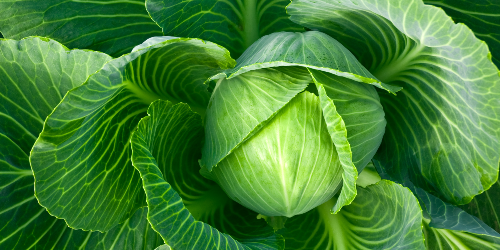WHITE CABBAGE
For the cultivation of white cabbage, clay soils, bogs, chernozems, black earth, loess and sandy loam soils are suitable when sufficiently moist. Avoid soils that are light, sandy and too dry, as well as acidified. The best soils are those with a pH of 6.2-7.7. White cabbage is a vegetable with high nutritional requirements; it provides the best yields in the first year after applying manure. The doses of mineral fertilizers applied to the soil depend on the abundance of nutrients available to plants in the soil, on the amount of introduced organic fertilizers, and on irrigation in the plantation and the cultivar's earliness. The fertilizer doses calculated based on chemical analysis of the soil should be reduced by the number of components introduced with manure or green fertilizers. If soil analysis has not been performed, then the number of mineral fertilizers per hectare with the full dose of manure should be 100 kg N, 70-90 kg P2O5, 200-240 kg K2O. If the plantation is irrigated, the fertilizer doses can be increased by up to 50%, especially nitrogen (leaching).
|
OPTIMAL CONTENT (in mg/dm3 of SOIL) OF NUTRITIONAL COMPONENTS IN SOIL FOR WHITE CABBAGE |
|
| M | 105-120 |
| P | 50-60 |
| K | 160-190 |
| Mg | 700-1200 |
RED CABBAGE
The requirements of red cabbage are similar to those of white cabbage. Red cabbage, however, is more sensitive to drought and water scarcity in the soil. It requires soil that is more fertile and richer in humus. It performs best on chernozems, black soil, lighter alluvial soils, podzols and humus-rich boggy soils. Red cabbage requires a pH in the range of 6.2-7.8. Red cabbage requires more potassium. Potassium greatly increases the yield and causes a more intense color of the leaves. Excessive nitrogen fertilization reduces the number of pigments in the leaves. The fertilizer doses calculated based on chemical analysis of the soil should be reduced by the number of components introduced with manure or green fertilizers. If soil analysis has not been performed, then the number of mineral fertilizers per hectare with the full dose of manure should be 100 kg N, 70-90 kg P2O5, 200-270 kg K2O. If the plantation is irrigated, the fertilizer doses can be increased by up to 50%, especially nitrogen (leaching).
| OPTIMAL CONTENT (in mg/dm3 of SOIL) OF NUTRITIONAL COMPONENTS IN SOIL FOR RED CABBAGE | |
| N | 110-130 |
| P | 56-60 |
| K | 200-220 |
| Mg | 55-65 |
| Ca | 700-1200 |
SAVOY CABBAGE
Savoy cabbage has a lower climate and soil requirements than white cabbage. It is less sensitive to low temperatures and drought. Soil cultivation and fertilization are the same as for the early white cabbage. The fertilizer doses calculated based on chemical analysis of the soil should be reduced by the number of components introduced with manure or green fertilizers. If soil analysis has not been performed, then the number of mineral fertilizers per hectare with the full dose of manure should be 100 kg N, 70-90 kg P2O5, 200-240 kg K2O. If the plantation is irrigated, the fertilizer doses can be increased by up to 50%, especially nitrogen (leaching).
| OPTIMAL CONTENT (in mg/dm3 of SOIL) OF NUTRITIONAL COMPONENTS IN SOIL FOR SAVOY CABBAGE | |
| N | 105-120 |
| P | 50-60 |
| K | 160-190 |
| Mg | 55-65 |
| Ca | 700-1200 |
BRUSSELS SPROUTS
Brussels sprouts have lower nutritional requirements than white cabbage. It gives good yields on almost all soils with regulated air-water ratios, rich in humus and calcium. Brussels sprouts require a pH in the range of 6.2-7.8. It is good to grow Brussels sprouts in the 2nd year after manure. Brussels sprouts require a lot of calcium and potassium. In the case of calcium shortage, internal browning of the heads occurs; in the case of a deficiency of potassium, the heads are loose. This cabbage also requires more boron. In the absence of this component, young leaves are light green, deformed, twisted, stiff and brittle. Stems with apical buds and growth tips turn brown and die off. Plants are also sensitive to molybdenum deficiency. This deficiency causes the leaves to change color from green to gray or blue-green. Chlorosis and necrosis develop at the edges of leaves in the stem tips, and the youngest leaves tend to rot. If soil analysis has not been performed, then the number of mineral fertilizers per hectare with the full dose of manure (in the second year after manure, Brussels sprouts should be grown) should be 150-200 kg N, 70-120 kg P2O5, 200-250 kg K2O. If the plantation is irrigated, the fertilizer doses can be increased by up to 50%, especially nitrogen (leaching).
| OPTIMAL CONTENT (in mg/dm3 of SOIL) OF NUTRITIONAL COMPONENTS IN SOIL FOR BRUSSELS SPROUTS | |
| N | 105-120 |
| P | 60-70 |
| K | 190-220 |
| Mg | 65-75 |
| Ca | 1000-1500 |
Fertilization technologies
Taking into account the different expectations of farmers in terms of crop nutrition, we have prepared for you three complete proposals for foliar fertilization.
The following technologies have been prepared in response to these expectations, in order to optimally nourish the crop and are for reference. If you have any questions regarding the details of the technology and the adjustment of the individual dosage of the indicated products, we invite you to contact our Team.
















